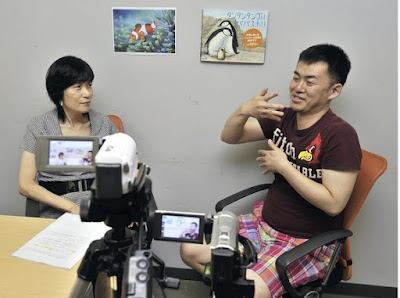Explorations and experiments in visual representations - multimodality, sensory ethnography, reflexivity, autoethnographic vignettes, ethnographic photography and ba...

Tuesday, October 20, 2015
"Deaf student plans thesis in sign language"
Photo, chart and story borrowed from The Japan News, October 15, 2015.
A graduate school student, born without the ability to hear, has become the first person in Japan to undertake the challenge of completing a master’s degree thesis through sign language instead of by means of written Japanese.
Shinya Kawabata, 36, studying at the Japan College of Social Work in Kiyose, western Tokyo, has been video recording the sign-language thesis for presentation in DVD format to the graduate school. He has been receiving sign-language instruction from Prof. Kurumi Saito, a specialist in linguistics.
Mitsuji Hisamatsu, chief of the secretariat of the Japanese Federation of the Deaf (JDF), points out the challenges students with hearing disabilities face. “Because answers to examinations and theses at a great majority of universities in Japan have to be written in Japanese, those deaf-mute students who are good at sign language but not so good at the Japanese language have been greatly disadvantaged,” he said.
Kawabata and Prof. Saito aimed to put sign-language theses on the same level as written ones. In exchanges between the two, Kawabata posed such questions as, “How does one quote part of a thesis written by another researcher?” to which Prof. Saito replied, “When you quote a researcher’s thesis for the first time, you should spell out the person’s full name and make it clear what page of the thesis you have made the quotation from.”
In addition to his hearing disability, Kawabata also identifies as gay. After entering the graduate course of the college in April last year, he has been studying methods of supporting “dual minority” individuals who are both deaf-mute and members of one or more sexual minority groups known collectively as LGBT (lesbian, gay, bisexual and transgender).
As the title of his master’s thesis, Kawabata has chosen “Support for the deaf LGBT by means of sign language.”
In addition to describing the current state of the deaf LGBT community, he is incorporating into his thesis key points for social workers to take into account when giving advice to deaf and LGBT persons. These include “being aware of the existence of people who do not belong to the ‘man or woman’ categories” and “refraining from communicating via e-mail at times when face-to-face sign language communication is necessary.”
Because sign language and the Japanese language differ widely in both vocabulary and grammar, many deaf-mute people find it hard to read and write in Japanese. Kawabata is literate in Japanese to some extent, but has found it difficult to write a master’s degree thesis in the language.
Prof. Saito thus came up with a proposal in July that led college authorities to change the rule on graduate school theses and agree to accept “sign-language theses” in addition to ones written in Japanese and English. Prof. Saito noted that Kawabata’s sign-language master’s thesis is the first to be undertaken in Japan.
For the project, Kawabata uses video cameras and other devices to record himself signing the contents of respective chapters. After sending the recorded chapters to Prof. Saito for review, Kawabata rerecords them in response to instructions given by the professor in sign language or through e-mails. His goal is to capture each chapter in a 10-minute video.
“Although I earlier thought that, in spite of the difficulties, there would be no alternative to writing my thesis in Japanese, I now feel relieved that presentation of my thesis in sign language has been approved,” he said with a smile. As Prof. Saito put it, “I earnestly wished to enable Kawabata to produce his thesis in sign language, by which he will be able to express whatever meaning he wishes to convey.”
Kawabata finished recording the thesis in mid-September, with the finished product constituting about two hours of video in total. After undergoing one more round of review by Prof. Saito, the thesis is scheduled to be transferred to DVD format for presentation to the graduate school in January next year. A Japanese translation of the thesis, completed with the help of a sign language interpreter, will be added to the DVD as reference material, the professor said.
“We would like to see this country turn into a society in which everyone is able to express his or her ideas and opinions in either Japanese or sign language and receive appropriate evaluations for each of them,” Hisamitsu said.
Measures for popularizing sign language have been spreading both at home and abroad.
In 2006, the United Nations adopted the Convention on the Rights of Persons with Disabilities with the aim of positioning sign language as equal to spoken languages and helping expand the places in which sign language can be used. About 50,000 people use sign language in Japan, according to a survey by the Health, Labor and Welfare Ministry conducted in 2006.
The number of local governments that have issued “sign language promotion ordinances” to encourage the use of sign language currently stands at 18 across the country, including Tottori and Kanagawa prefectures. Services for helping people use sign language have also been increasing among local municipalities and in the private sector.
Source: http://the-japan-news.com/news/article/0002465783
Subscribe to:
Post Comments (Atom)


No comments:
Post a Comment